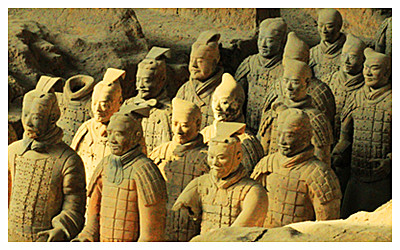Skype: neodalle-travel
Tel: +86 135 7447 2266
E-mail: sales@visitaroundchina.com
Shaanxi is considered one of the cradles of Chinese civilization. Thirteen feudal dynasties established their capitals in the province during a span of more than 1,100 years, from the Zhou Dynasty to the Tang Dynasty.
 About 800,000-1,200,000 years ago, Lantian Man had already lived their lives on this land by using simple tools, collecting fruits and seeds as well as hunting animals. The Banpo Ruins, a representative site of matriarchal clan society dating back 5,600-6,700 years ago, was found in the eastern part of its present capital city, Xian.
About 800,000-1,200,000 years ago, Lantian Man had already lived their lives on this land by using simple tools, collecting fruits and seeds as well as hunting animals. The Banpo Ruins, a representative site of matriarchal clan society dating back 5,600-6,700 years ago, was found in the eastern part of its present capital city, Xian.
Shaanxi was established as a provincial government since Qing Dynasty. On 10 January 1950, the People's Government of Shaanxi was established in Xi'an. Ma Minfang was then appointed as the first Governor of Shaanxi.
The province's principal city and current capital, Xi'an, is one of the four great ancient capitals of China and is the eastern terminus of the Silk Road, which leads to Europe, the Arabian Peninsula and Africa.
Under the Han Dynasty, the Northern Silk Road was expanded to advance exploration and military purposes to the west. This Northern Silk Road is the northernmost of the Silk Roads and is about 2,600 kilometres (1,600 mi) in length. It connected the ancient Chinese capital of Xi'an to the west over the Wushao Ling Pass to Wuwei and emerging in Kashgar before linking to ancient Parthia.
As one of the most important dynasties in Chinese history, Tang Dynasty was established by Emperor Gaozu - Li Yuan, with Chang'an (Xian today) as the capital. China had ever been the strongest country in the world, enjoying a history of 289 years. Tang's brilliant culture, politics and economy had great influence on the neighbor countries Silla, Bohai and Japan at that time. As a result, nowadays Chinese people are also named 'Tang people', and in the western countries, the residential places that Chinese people live in are given the name 'Tang Ren Jie'(China Town).
After the Tang Dynasty, Xi’an, although not serving as the capital city, still played an extremely important role in national politics and especially in the military.
Under the Ming dynasty, Shaanxi was incorporated into Gansu but was again separated in the Qing dynasty.
One of the most devastating earthquakes in history occurred near Huashan Mountain, in south-eastern part of Shaanxi Province on January 23, 1556, killing an estimated 830,000 people.
The end of the short-lived Jiangxi Soviet signalled the beginning of the Long March by Mao Zedong and the Chinese Communists to the Shaanxi Soviet at Yan'an.
 Ask Questions ?
Ask Questions ?